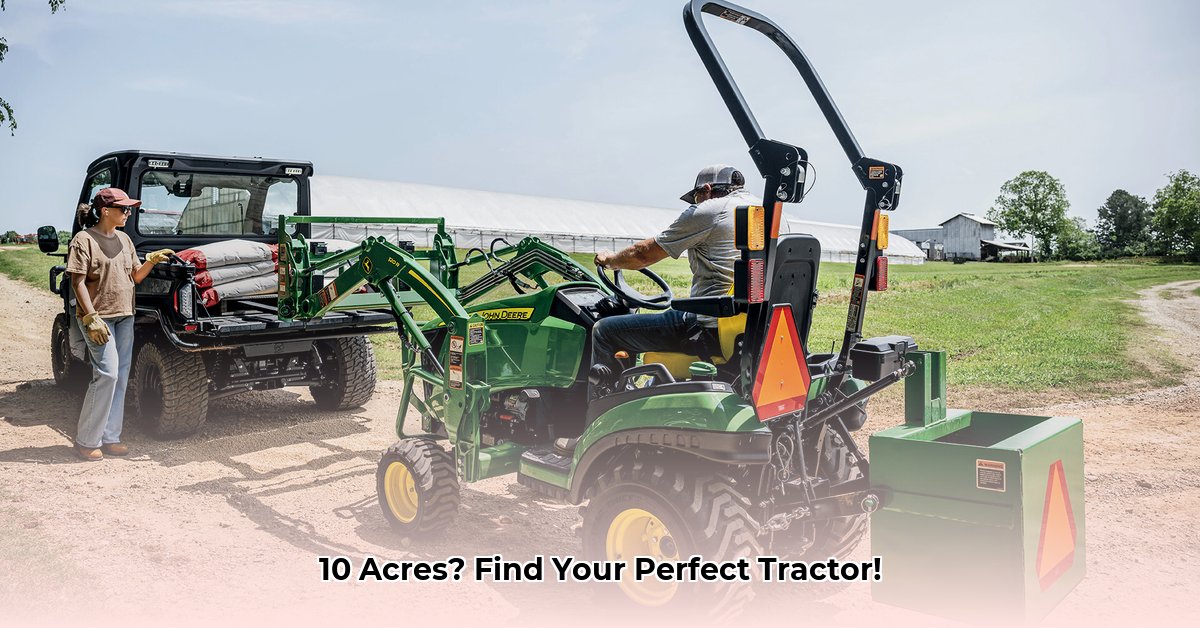
Best Tractor for 10 Acres: A Comprehensive Buying Guide
Buying a tractor for your 10-acre property is a significant investment. This guide will help you navigate the process, ensuring you select the optimal machine for your needs and budget, while prioritizing sustainable farming practices. We'll demystify the jargon and focus on practical, actionable steps. For more tractor brand comparisons, check out this helpful resource.
Assessing Your Farming Needs: Beyond Acreage
Ten acres offers diverse possibilities, from vegetable gardens to livestock grazing. What are your primary farming activities? Hay cutting? Tilling? Livestock management? Understanding your current and future goals—will you expand?—directly impacts the necessary horsepower and features. A clear plan is crucial before you begin your tractor search. For example, intensive vegetable production requires different implements than pasture management.
Horsepower: Finding the Right Fit for Your 10 Acres
Horsepower (HP) is critical. Insufficient power leads to frustration and inefficient work; excessive power results in unnecessary expense and maneuverability challenges. For a 10-acre operation, a compact utility tractor (CUT) in the 35-50 HP range is typically sufficient, particularly for diverse farming activities. Smaller tractors may struggle with heavy tasks like plowing heavy clay soil, while larger models can be cumbersome in confined spaces. What tasks will determine your horsepower needs?
Essential Tractor Features: Maximizing Versatility
Several crucial features enhance a CUT's versatility on a 10-acre farm:
Three-Point Hitch: This system connects implements (tillers, mowers, loaders) to your tractor—essential for any serious farming operation. Consider this your tractor's primary attachment point for all your tools.
Power Take-Off (PTO): This powers many implements, acting as a secondary engine driving the equipment attached to the three-point hitch. A strong PTO ensures efficient operation.
Hydraulics: These manage implement functions. Sufficient hydraulic flow and lift capacity are needed for diverse tasks. The hydraulics determine how much force you can exert to lift or manipulate equipment.
Ground Clearance: Adequate ground clearance prevents snagging on uneven terrain. Consider your acreage's characteristics and the type of soil you're working with.
Cab (Optional but Recommended): A cab enhances comfort and protection from weather elements, especially during long workdays. A cab is a worthy investment for all-weather operation and operator well-being.
New vs. Used Tractors: Weighing the Pros and Cons
The decision between a new and used tractor depends on your budget and risk tolerance.
New Tractors:
- Advantages: Warranties, latest technology, often better fuel efficiency.
- Disadvantages: Higher initial cost, depreciation.
Used Tractors:
- Advantages: Lower purchase price, potentially lower maintenance (depending on condition and maintenance history).
- Disadvantages: Potential for repairs, uncertain history, limited or no warranty.
A pre-purchase inspection by a qualified mechanic is strongly recommended for used tractors. "A thorough inspection can often save you significant costs down the line," says John Miller, Senior Mechanic at Acme Tractor Repair.
Sustainable Farming Practices: Minimizing Your Environmental Impact
Sustainable farming is crucial. Fuel efficiency directly impacts your environmental footprint. Consider these elements:
Fuel-efficient tractors: Look for models with optimized engine designs and fuel injection systems. Consider the long-term fuel cost.
Alternative fuels: Explore the compatibility of biodiesel or other alternatives. What are the long term expenses?
Precision agriculture technologies: GPS guidance systems optimize work, reduce fuel consumption, and minimize chemical inputs.
Choosing Your Tractor: A Step-by-Step Action Plan
Follow these steps for a successful tractor purchase:
Analyze Your Farming Plan: Define tractor tasks to determine necessary power, features, and implements.
Set a Realistic Budget: Consider financing options. Budget for maintenance and potential repairs.
Research Tractor Models: Compare specifications and features across brands. Review online reviews and seek farmer recommendations. The more research you do, the better informed your decision will be.
New vs. Used: Re-evaluate: Consider your budget and risk tolerance. A pre-purchase inspection is essential for used tractors.
Test Drive (If Possible): Evaluate size, maneuverability, and ergonomics. How easy is the tractor to operate?
Plan for Growth: Will this tractor suit your future farming needs?
Prioritize Sustainability: Consider fuel efficiency and environmental impact.
Making the Informed Decision: Your 10-Acre Tractor Journey
Selecting the right tractor is a significant decision affecting your farming success and sustainability. Careful planning, thorough research and a realistic budget will help you find the perfect machine for your 10-acre property. Remember, the best tractor aligns with your specific needs and farming style. Consult with experienced farmers for valuable insights and guidance. Don't hesitate to ask questions and seek out expertise.